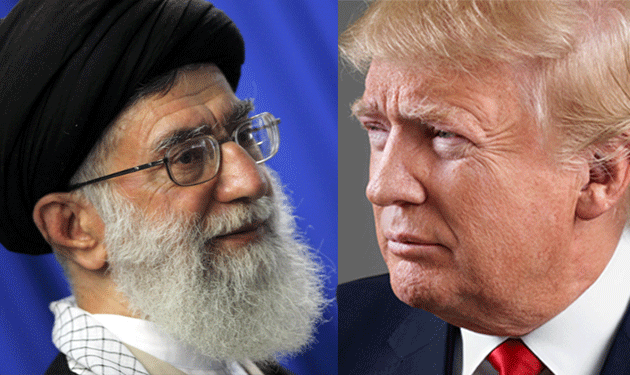Trump Has Ended ‘Proportionate Warfare’ against Iran — Will It Last?
A.J. Caschetta/The Hill/January 09/2020
أي كاسشيتا/مجلة الهل: ترامب انهى حقبة الحرب النسبية ضد إيران، فهل سيستمر هذا الوضع على حاله؟
Following Iran’s firing of 15 missiles at Iraqi bases housing U.S. troops last night, Iranian Foreign Minister Javad Zarif tweeted that “Iran took & concluded proportionate measures in self-defense.”
Even if early reports are accurate that the missiles killed no Americans — perhaps even deliberately — the days when Iran could count on its aggression being met by a “proportionate” response from Washington may be over.
Iran’s proxy forces assaulted the U.S. embassy in Baghdad late last month and, in response to a purported “imminent attack” organized by Iran’s Islamic Revolutionary Guard Corps (IRGC), President Trump took the splendidly disproportionate step of killing General Qassem Soleimani, the leader of the IRGC’s Quds Force, and Abu Mahdi al-Muhandis, the commander of the Iranian-sponsored Popular Mobilization Forces (PMF), thus breaking what journalist Jonathan Tobin called “the wheel of appeasement.”
This followed the equally disproportionate killing days before of 25 Kataib Hezbollah fighters who killed one American contractor.
Trump seems to have ended, at least temporarily, the era of proportionate warfare against Iran.
The folly of fighting a “proportionate” war — the type imposed upon Israel — is self-evident to those who understand that wars are won by the sides that inflict more damage than they receive. Fighting proportionately only prolongs wars and produces stalemates.
House Speaker Nancy Pelosi (D-CA) is a proponent of proportionality. In 2017, after Syria’s Bashar al-Assad used chemical weapons on civilians, she applauded Trump’s “proportionate” strike on the chemical weapons facility in Syria, but this time, she complained that killing Soleimani was “provocative and disproportionate.”
Trump himself is using the term as if finally responding to criticism. For example, answering an IRGC claim that “some 35 U.S. targets are within our reach,” Trump replied on Saturday that he is eyeing 52 sites in Iran. And then on Sunday, he tweeted a warning: “Should Iran strike any U.S. person or target, the United States will quickly & fully strike back, & perhaps in a disproportionate manner.”
It wasn’t always this way. In May 2019, the IRGC began harassing and sabotaging ships in the Persian Gulf. In June, after Iran downed an American drone conducting surveillance in the area, Trump said the U.S. military was “cocked and loaded,” ready to hit Iran hard in retaliation. But at the last minute, the president called off the attack — mid-flight, according to his tweet — after learning that up to 150 people might be killed in the attack. It would not be proportionate, he said.
After Iranian drones struck Saudi Arabian oil fields on Sept. 14, the world waited for a U.S. or Saudi response. This time, Trump said that the military was “locked and loaded.” But again nothing happened, proportionate or otherwise.
For a while, many agreed that Trump’s restraint was a problem. The New York Times investigation into “The Secret History of the Push to Strike Iran” concluded that his “tendency to bluster about American power, but avoid actually using it, has made the situation in recent months even more volatile.”
Even from the right, Trump’s critics wanted action — but proportionate action. Sen. Lindsey Graham (R-S.C.) offered the ultimate in proportionate tit-for-tat, tweeting: “It is now time for the U.S. to put on the table an attack on Iranian oil refineries.”
Graham was right that “Iran will not stop their misbehavior until the consequences become more real, like attacking their refineries, which will break the regime’s back,” but proportionately destroying Iranian oil refineries could be counterproductive, hindering the peaceful government everyone hopes one day will replace the current regime and perhaps rousing more anti-Americanism. Better to strike disproportionately at Iranian forces and proxies at the borders of the Iranian empire: Syria, Lebanon, Iraq, Yemen. Just as sanctions are shrinking Iran’s economy, crippling its proxies will shrink its influence.
This is precisely what Trump did on Dec. 29 after an American contractor was killed and others wounded by missile fire from Kataib Hezbollah in Kirkuk, Iraq, on Dec. 27. Rather than killing one Iranian proxy member in a “proportionate” response, the larger strike killed up to 25. A 25-to-1 ratio might deter some enemies, but in the 1980s, Ayatollah Ruhollah Khomeini sent thousands of Iranian children to die as martyrs in human wave attacks against Iraq. Now, Ayatollah Ali Khamenei would just as willingly sacrifice Arabs and Iranians as martyrs to his cause. He is less willing to sacrifice his war-making materiel.
Predictions about Iranian retaliation for Soleimani’s death have run the gamut from cyber attacks to more assaults on U.S. embassies. Few believe that last night’s missiles are the end of it. One likely form of Iranian retaliation is additional sabotage in the Persian Gulf, where the IRGC’s estimated 1,500 boats are the primary source of Iranian harassment, whether they are attaching limpet mines to oil tankers or seizing them and their crews.
It was an IRGC boat that seized 10 U.S. Navy sailors and held them captive in January 2016. President Obama did not respond, proportionately or otherwise. Instead, he invited more mischief by having Secretary of State John Kerry negotiate for their release and then issued a statement expressing “gratitude to Iranian authorities for their cooperation in swiftly resolving this matter.” The IRGC is a designated foreign terrorist organization, so its assets, including its navy, could be targeted and its ships sunk whenever they are encountered.
Iran has been at war with the U.S., ideologically, since Feb. 1, 1979, when Khomeini’s airplane landed in Iran, ending his exile in France and establishing the Islamic Republic. Its first physical attack against the U.S. came on Nov. 4, 1979, when Khomeini’s followers stormed the U.S. embassy in Tehran and held diplomats hostage for 444 days.
The U.S. has been fighting Iran proportionately for almost 40 years, exercising restraint and attempting diplomacy. By returning fire, Trump has changed that pattern.
What we don’t know is whether the president had an epiphany and the emphasis on disproportionate fighting augurs a new policy, or if are we witnessing just another ephemeral twist in the unpredictable foreign policy of an unpredictable president.
A.J. Caschetta is a Ginsberg-Ingerman fellow at the Middle East Forum and a principal lecturer at the Rochester Institute of Technology.





















